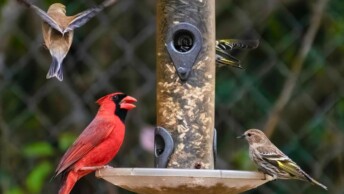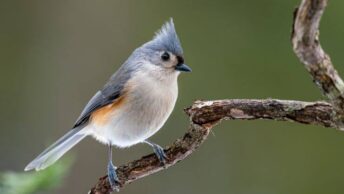Across the avian world, some species are so brightly colored they look almost cartoonish. The Gouldian finch, paradise tanager, mandarin duck, rainbow lorikeet, and painted bunting stand out as the most colorful birds, their plumage arranged in palettes that suggest nature was thinking like an artist.
While many bird species exhibit vivid coloration, this list highlights those with the most complex or uniquely striking plumage. We’ve gathered birds that display exceptionally diverse or bold color palettes, selecting standout examples from across different families – remarkable even among their most vibrant relatives.
Painted Bunting
Passerina ciris
- Color palette: Blue, lime green, scarlet, and yellow.
- Plumage notes: Males retain full coloration year-round; females dull green throughout.
- Where found: Shrubby fields and forest edges in the southeastern and south-central U.S.; winters in Florida, the Caribbean, and Central America.
- Conservation status: Least Concern.
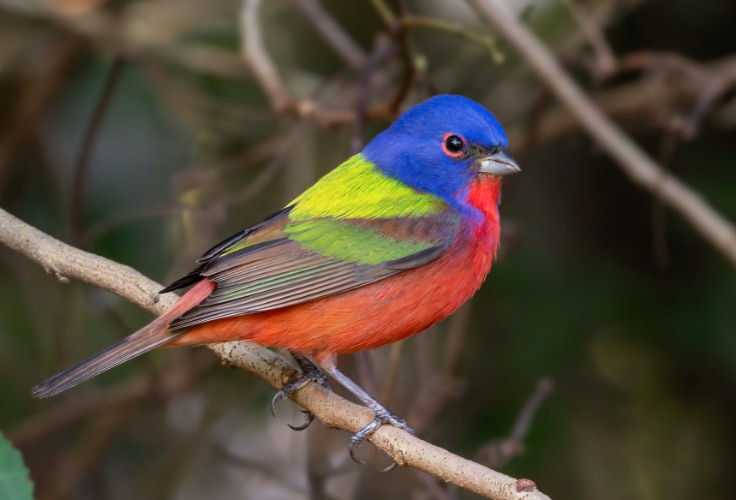
The painted bunting is often considered the most strikingly colorful songbird in North America, with males combining rich blue, lime green, and fiery red in a plumage that almost defies belief.
The head is a deep cobalt-blue, the back a vivid green, and the underparts a glowing scarlet that intensifies toward the belly. The wings are darker with greenish edges, and the tail is dusky. Females contrast completely – cloaked in smooth, leaf-green tones that provide excellent camouflage in dense vegetation.
Males keep their full breeding colors year-round, with no dramatic seasonal molt. Courtship displays are lively and somewhat theatrical: males perform on the ground or in low vegetation by puffing up, spreading their wings and tail, and fluttering with stiff, jerky movements. They may also perform hovering flights or give wing-quivering displays to attract females.
Painted buntings breed in two widely separated U.S. populations: one along the Atlantic Coast from North Carolina to Florida, and a larger one in the south-central U.S., centered in Texas, Oklahoma, and parts of northern Mexico. They prefer brushy edges, weedy fields, and semi-open woodland with scattered cover. In winter, eastern birds migrate to Florida and the northern Caribbean, while western birds head through Mexico to Central America.
Despite adaptability to some managed habitats, the species faces ongoing threats. Habitat loss, particularly along the Atlantic coast, and illegal trapping for the cage bird trade remain serious concerns. Though protected in the U.S., significant numbers are still captured in Mexico and Cuba.
Conservation efforts have focused on habitat protection and monitoring programs, but long-term success will depend on halting trade and preserving key breeding and wintering grounds.
Mandarin Duck
Aix galericulata
- Color palette: Copper-red, green, purple, orange, white, and maroon.
- Plumage notes: Males molt into dull eclipse plumage outside breeding season.
- Where found: East Asia; introduced in Europe and parts of North America.
- Conservation status: Least Concern.
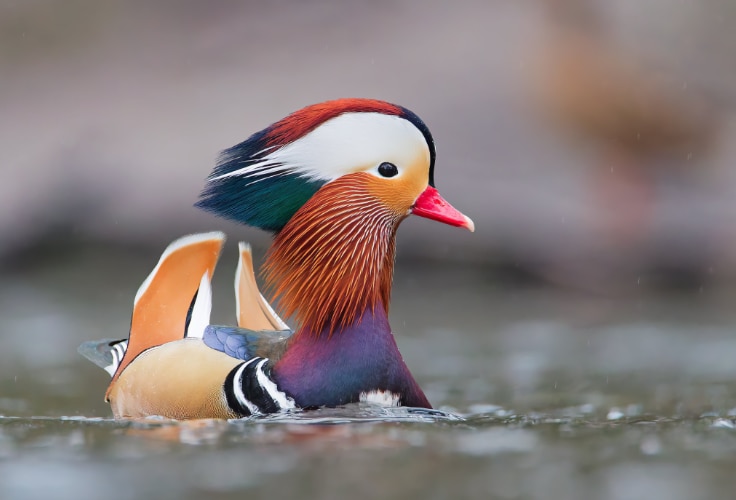
The mandarin duck is one of the world’s most extravagantly plumaged waterfowl, instantly recognizable and often considered the most beautiful duck in the world. In breeding season, the male displays a flamboyant combination of iridescent green, violet, and coppery-red hues across his head and crest, with vivid orange “sails” – raised feathers along the back, and bold white face lines.
His chest is deep maroon, sides are barred with black and orange-white, and the flanks are snow white. The bill is red with a pale tip, and legs are orange-buff. Females are more subdued, gray-brown with fine spotting and a white eye ring that extends behind the eye.
Males lose their ornate breeding plumage after the season, entering a cryptic eclipse phase that resembles the female. Outside of molt, they remain visually striking mainly during courtship, when they use elaborate displays to showcase their plumage – flaring sails, puffing crests, and synchronized swimming behaviors are common. The bright coloration and feather positioning play a key role in mate attraction.
Native to East Asia, the mandarin duck breeds in forested wetlands and wooded river valleys across eastern Russia, northeast China, Korea, and Japan. It prefers still or slow-moving water with abundant vegetation. Declines due to deforestation and historic exportation have been partially offset by legal protections and reforestation efforts in Japan and reserves in China and Russia.
While wild populations remain scattered, the species has rebounded in some areas. It is also thriving in introduced populations in the UK, Germany, and parts of North America, where it has adapted well to parks and garden lakes.
Paradise Tanager
Tangara chilensis
- Color palette: Light green, black, red, yellow, and blue.
- Plumage notes: No seasonal changes; sexes are alike; minor regional variation in rump color.
- Where found: Canopy of Amazonian rainforests across northern and central South America.
- Conservation status: Least Concern.

The paradise tanager lives up to its name with one of the most dazzling plumage combinations in the Amazon rainforests. Its apple-green head contrasts sharply with a black back and tail, while the lower back blazes red and the rump glows yellow or red, depending on the region. The throat is dark blue, fading to a brighter, turquoise-blue breast and flanks. Black wings with blue coverts add further contrast.
Paradise tanagers molt once a year, likely after the breeding season, without any dramatic shift in appearance. Their year-round colors remain vibrant. These birds are active and fast-moving, often joining mixed-species flocks as they forage quickly among the treetops. While no elaborate display is documented, their vivid coloration is a key feature in social interactions and mate selection.
This species is found throughout the lowland and foothill forests of the Amazon Basin, including parts of Colombia, Venezuela, Ecuador, Peru, Bolivia, Brazil, and the Guianas. It prefers the upper canopy of evergreen rainforest, typically between 25 and 50 meters (80-160 feet) high, but may descend into the midstory at fruiting trees or forest clearings.
Though one subspecies has a relatively narrow range in north-central Peru, the species overall is widespread and commonly observed within intact forest. It remains stable and secure across most of its range, with no significant threats currently impacting populations.
Keel-Billed Toucan
Ramphastos sulfuratus
- Color palette: Black, yellow, red, and multi-colored bill with green, blue, orange, and maroon.
- Plumage notes: Undergoes annual molt after nesting; males and females similar in appearance.
- Where found: Lowland forests from southern Mexico to Colombia and Venezuela.
- Conservation status: Near Threatened.
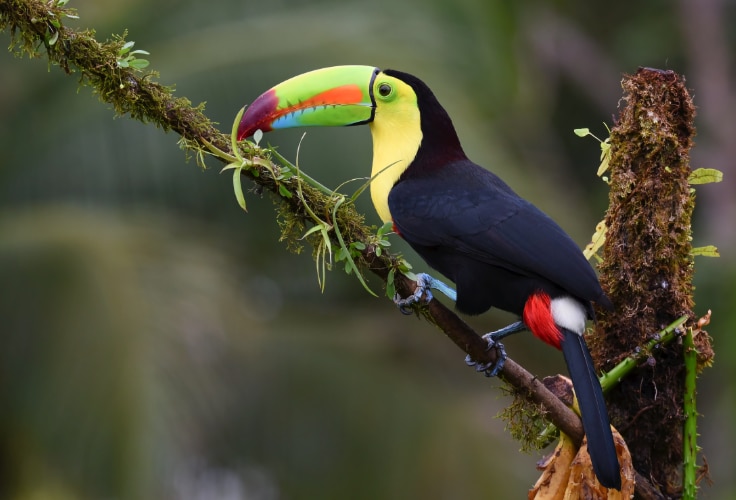
Among the many colorful toucans of the Americas, the keel-billed toucan stands out as the most dazzling, earning it the name “rainbow-billed toucan.” Its oversized, vividly multi-colored bill combines green, orange, blue, and maroon in an unmatched palette.
The body is mostly black with a lemon-yellow throat and breast, a red band along the lower chest, and scarlet under-tail coverts. Upper tail coverts are white, while the bare facial skin adds flashes of yellow-green. Males and females look alike, though males are slightly larger.
This species undergoes a single annual molt after the breeding season, with feather replacement following a consistent and symmetrical pattern across the wings and tail. Though not as dramatically seasonal as in some birds, molting still affects overall brightness. During courtship, the toucan’s bright bill is prominently displayed, and its frog-like croaking call carries through the canopy.
The keel-billed toucan inhabits humid lowland rainforests, mostly on the Caribbean slope from southern Mexico to northern South America. It prefers the forest canopy and edges of mature woodlands but also adapts to plantations and second growth. Despite its vivid colors and size, it can be surprisingly difficult to spot as it moves deliberately through foliage.
The species is declining due to accelerating habitat loss, especially in areas of forest conversion and fragmentation. Hunting and trapping for the pet trade further threaten local populations. Though protected in parts of its range, effective long-term conservation will depend on habitat protection, population monitoring, and reducing demand for the pet trade.
Gouldian Finch
Chloebia gouldiae
- Color palette: Green, purple, yellow, blue, black, and multi-colored face (black, red, or yellow).
- Plumage notes: Males are brighter; face color varies naturally; annual molt after breeding.
- Where found: Northern Australia, in open woodland and grassy savanna.
- Conservation status: Least Concern.
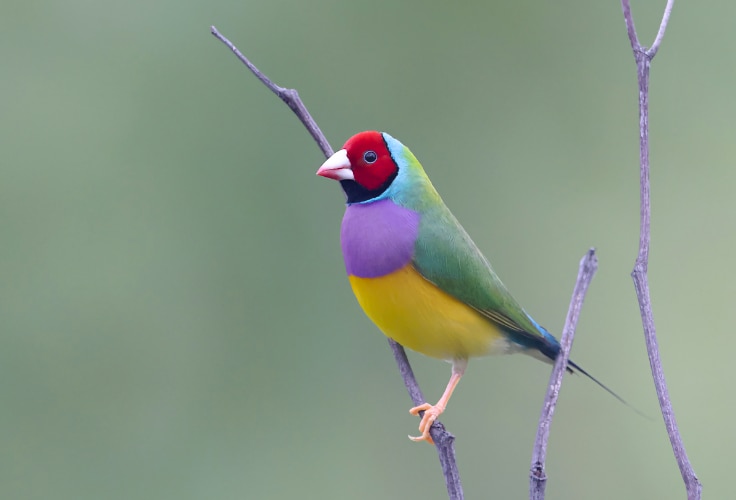
The Gouldian finch is one of the most vividly colored finches in the world, and among the most striking birds of Australia. Its dazzling plumage features a green back, violet chest, yellow underparts, and a pale blue nape, set off by a boldly contrasting black throat.
What makes it even more eye-catching is the natural variation in face color – individuals may have red, black, or yellow faces, giving the species a kaleidoscopic appearance in flocks. Males are more intense in color than females, who share the same pattern but in more subdued tones.
This species molts once per year following the breeding season, gradually replacing its feathers in a symmetrical, tract-based sequence. Courtship displays are lively, with males fluffing their vivid face and chest feathers, bobbing, and singing while raising and angling the tail toward the female. Interestingly, they tend to choose mates with the same face-color morph, a rare example of assortative mating in wild birds.
Gouldian finches inhabit open, tropical woodlands and grassy savannas across northern Australia, particularly in areas that maintain a mosaic of burnt and unburnt habitat. They rely on native grasses for seed and nest in tree cavities, typically near water sources.
While no longer trapped for the pet trade, the species remains sensitive to landscape changes. Frequent intense fires, overgrazing, and loss of seeding grasses during the wet season can affect food availability and nesting success. However, fire and grazing management at key sites, combined with captive breeding programs and community engagement, have stabilized the population, and several recovery actions continue to support its future.
Red-Naped Trogon
Harpactes kasumba
- Color palette: Black, red, cobalt blue, brown, white, and yellow.
- Plumage notes: No seasonal change; females duller with yellow underparts.
- Where found: Lowland and foothill forests of southern Thailand, Malaysia, Sumatra, and Borneo.
- Conservation status: Near Threatened.
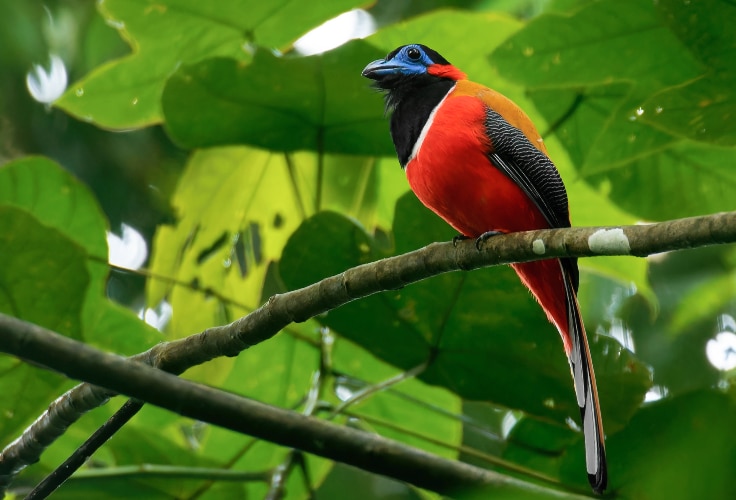
The red-naped trogon is one of Southeast Asia’s most colorful birds, yet it often goes unnoticed due to its slow, quiet movements and preference for dense understory. Males are unmistakable: a velvety black head and breast contrast sharply with a glowing red nape and belly, separated by a crisp white breast band.
The face is ringed in cobalt-blue skin, and the bill shares the same vivid hue. The back and upper tail are brownish-orange with subtle bronze gloss, while the wings are patterned black and white. Females are more subdued, with a dusky brown head and rich yellow underparts, but they still retain the blue facial highlights.
Plumage remains stable throughout the year, with no seasonal molt or eclipse phase. Courtship is little documented, but males are sometimes observed posturing or calling softly from mid-canopy perches, where the brilliance of their red and blue contrasts is naturally highlighted by filtered light. The undertail pattern, white tipped in black, is also likely displayed during pair interactions.
This species inhabits the middle to upper layers of evergreen and peat swamp forests across Peninsular Malaysia, southern Thailand, Sumatra, and Borneo. It prefers lowland and foothill elevations, though it may range up to 1,200 meters (4,000 feet) in Borneo.
While relatively common in some protected areas of Malaysia and Borneo, it has declined in Thailand and disappeared from Singapore. Habitat loss remains the greatest threat, particularly outside reserves. Though it persists in logged and secondary forest to a degree, long-term survival depends on the preservation of large tracts of mature forest across its fragmented range.
Rainbow Lorikeet
Trichoglossus moluccanus
- Color palette: Blue, violet, red, green, yellow, and orange.
- Plumage notes: Sexes alike; no seasonal changes.
- Where found: Wooded habitats and urban areas in eastern and northern Australia; introduced elsewhere.
- Conservation status: Least Concern.
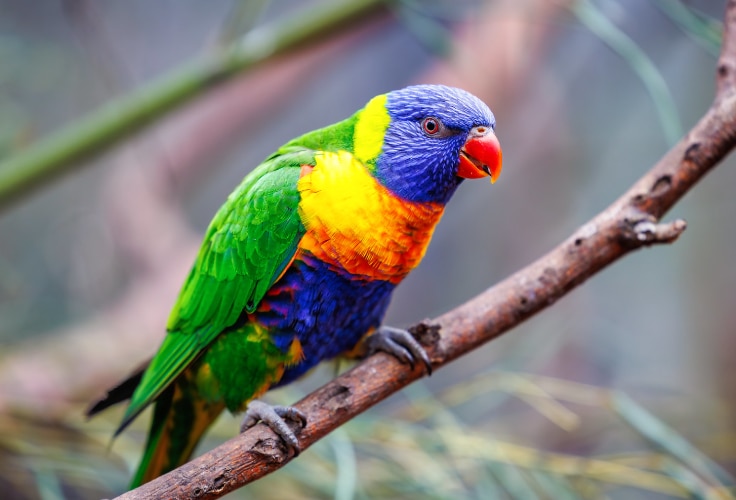
The rainbow lorikeet lives up to its name with plumage that blends bold bands of red, blue, green, and yellow into a seamless display of color.
The head is deep blue with violet flecking, contrasting with a bright yellow-orange breast and an orange-red bill. A yellow collar wraps the nape, while the back and wings are bright green, and the belly is dark blue to green. The underwings show orange and yellow, and the tail is olive-yellow beneath.
Both sexes look alike, and the intensity of color is consistent throughout the year. Courtship often involves synchronized head-bobbing, mutual preening, and feeding, but their coloration plays a less prominent role in display than in many other birds – their constant vocalizations and flock behavior dominate social interactions.
Rainbow lorikeets are native to eastern and northern Australia, ranging from Cape York to southeastern South Australia, and have become highly adaptable urban dwellers. They thrive in rainforests, open woodlands, coastal scrub, orchards, and suburban gardens, especially where flowering trees like eucalypts and bottlebrush are common.
Though locally declining in parts of Cape York and Victoria, they are increasing around major cities like Sydney, Melbourne, and Canberra. Feral populations are also established in Perth and Auckland, New Zealand. While not globally threatened, their success in altered landscapes has led to conflict in agricultural areas, where they are sometimes considered pests due to damage to fruit crops.
Regal Sunbird
Cinnyris regius
- Color palette: Iridescent green, violet, scarlet, yellow, and olive.
- Plumage notes: No seasonal change; males brightly iridescent, females dull and olive-yellow.
- Where found: Montane forests of the Albertine Rift, from eastern DRC to western Tanzania.
- Conservation status: Least Concern.
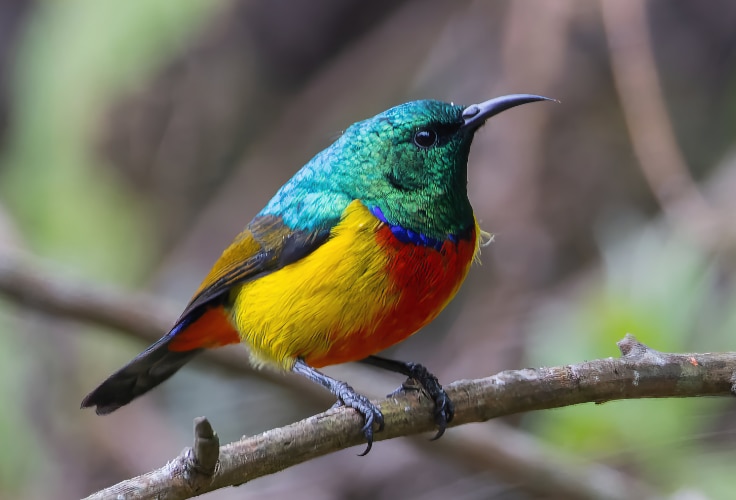
The regal sunbird is a jewel of Africa’s montane forests, with males showcasing one of the most vivid and intricate plumage patterns among sunbirds. The crown, back, and throat shimmer emerald-green, with a narrow violet band across the upper breast.
Below this, a bold patch of scarlet blends into bright yellow flanks, while the rump and undertail show violet and red accents. The tail has a violet sheen, completing the bird’s dazzling appearance. Females, in contrast, are muted olive above and yellow-green below, with faint streaking on the throat and no bright markings.
The species maintains its plumage throughout the year, with no dramatic molt or eclipse phase. Males use their vibrant colors in combination with short aerial flights, fluttering displays, and singing from exposed perches to attract mates.
The regal sunbird is found in the Albertine Rift mountains of eastern Democratic Republic of the Congo, southwest Uganda, western Rwanda and Burundi, and into western Tanzania. It inhabits montane forest and adjacent scrub, bamboo stands, and clearings at elevations from 1,500 to over 3,000 meters (4,900-10,000 feet).
Although localized, it remains common in suitable habitats and faces no major immediate threats. While forest degradation may impact some areas, the species persists across a relatively broad altitudinal range and benefits from several protected regions within its limited range.
Himalayan Monal
Lophophorus impejanus
- Color palette: Iridescent green, blue, red, orange, violet, black, white, and brown.
- Plumage notes: No seasonal molt; female duller; males vary slightly by region.
- Where found: High-altitude forests and alpine slopes of the Himalayas.
- Conservation status: Least Concern.
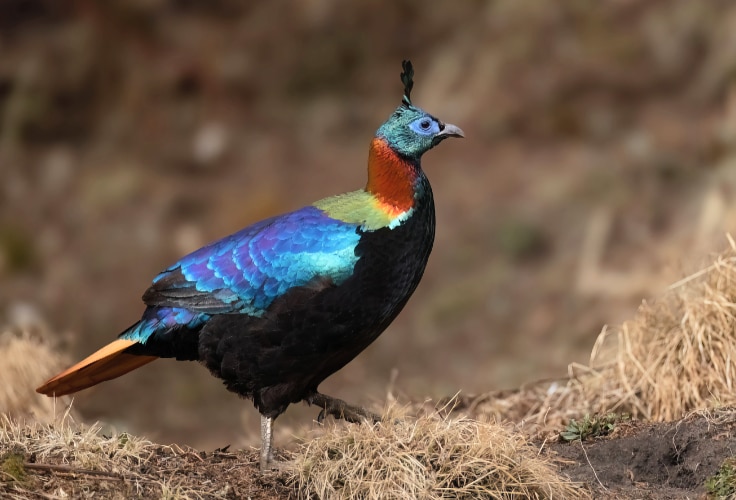
Often described as the most iridescent pheasant in the world, the Himalayan monal dazzles with an explosion of colors that shift with every movement. The male wears a metallic green head crowned with a wiry crest, cobalt-blue facial skin, and a scarlet neck and breast. The back glows with purples and bronzes, the tail is bright orange-rufous, and the underparts are black.
A white rump patch, often hidden, flashes conspicuously in flight. Females are cryptically patterned in mottled browns, with a pale throat, blue orbital skin, and barred tails – designed for concealment on the forest floor.
There is no seasonal molt into alternate plumage, though individual males can vary in breast and back color depending on region. During the breeding season, males court females by fanning their vivid tails, drooping their wings, and parading slowly with deliberate, side-facing postures. A dramatic aerial display also occurs, with the male gliding in a shallow arc while calling and showing off his striking plumage from above.
The species is widely distributed along the Himalayan range, from northeastern Afghanistan through northern India, Nepal, Bhutan, and into southeastern Tibet and northern Myanmar. It inhabits coniferous and mixed forests with rhododendron and bamboo understory, often shifting seasonally between alpine meadows in summer and lower elevations in winter.
The monal remains locally common, especially in protected areas like Nanda Devi, Langtang, and Khangchendzonga National Parks. However, hunting for meat and ornamental crests, habitat degradation, and snaring persist in parts of its range. Though still secure overall, continued protection of forest habitats and enforcement against poaching are essential to maintain its numbers.
Elegant Euphonia
Chlorophonia elegantissima
- Color palette: Turquoise-blue and orange in males; greenish with blue and rufous in females.
- Plumage notes: Retained year-round with no major seasonal change.
- Where found: Highlands and foothills from Mexico to western Panama.
- Conservation status: Least Concern.

Often described as one of the most beautiful finches of the Americas, the elegant euphonia lives up to its name with an unusual and vivid color scheme. Males wear a turquoise-blue crown and nape, a black face and back, and a rich orange underside that sets them apart from the typically blue-and-yellow euphonias.
Females also feature a blue hood but are more subdued overall, with green backs and underparts and a soft rufous blush on the forehead. Though small and often quiet, they are unmistakable when spotted among the foliage.
Both sexes maintain their coloration year-round. Their bright plumage is often displayed from the edges of mistletoe clumps, where males sing persistently. Elegant Euphonias tend to remain in pairs or small groups and are known to move seasonally and altitudinally, descending to lower elevations outside the breeding period.
This species ranges across montane forests and semi-open habitats from Mexico to western Panama, thriving especially in regions rich in mistletoe. It inhabits pine-oak woodlands, secondary growth, and plantations – particularly in humid, mid-elevation zones.
Though its population is decreasing slightly, the elegant euphonia remains fairly common across much of its range and persists in a variety of habitats, including several protected areas. Conservation concern is currently low, though continued habitat management will be important as pressure from agriculture and development expands in montane regions.
Fiery-Throated Hummingbird
Panterpe insignis
- Color palette: Emerald green, cobalt blue, copper-orange, violet, turquoise, and black.
- Plumage notes: Sexes alike; no seasonal molt; iridescence visible only from certain angles.
- Where found: Highland cloud forests of Costa Rica and western Panama.
- Conservation status: Least Concern.
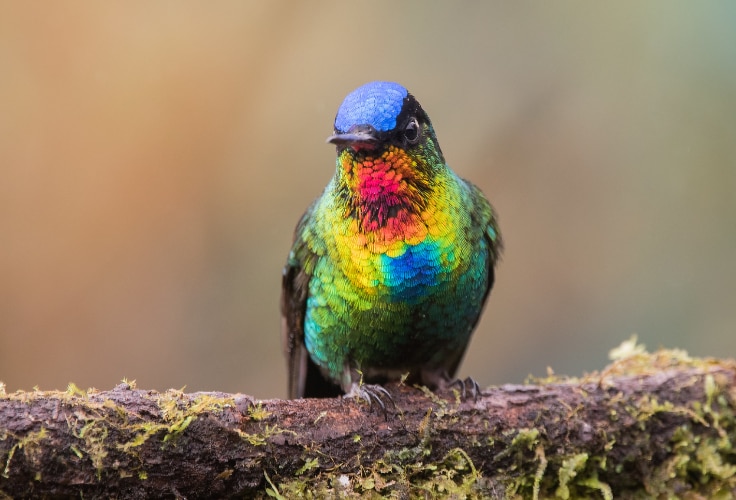
Even among the famously colorful hummingbirds, the fiery-throated hummingbird stands out with a throat that flashes nearly every color of the rainbow.
At first glance, it appears a shimmering green with a blue tail and a small white postocular spot. But when caught in the right light, the throat blazes with copper-orange framed by golden-green, while the breast glows with cobalt to violet. The crown flashes brilliant blue, and the belly shimmers green to turquoise.
These radiant effects result from highly evolved structural coloration in the feather barbules, producing multiple reflectance peaks and vibrant hues beyond ordinary pigmentation.
There is no sexual dimorphism or seasonal plumage shift in this species. Both sexes maintain their dazzling colors year-round, though the iridescence varies dramatically with viewing angle. Courtship and territorial behaviors often involve aggressive chases and display flights that flash the throat and crown – brief moments that transform the bird into a burst of living color.
The fiery-throated hummingbird inhabits high-elevation cloud forests, elfin woodlands, and forest edges from about 1,500 to 3,200 meters (5,000-10,500 feet) across the Talamanca and Central ranges of Costa Rica and western Panama. It prefers canopy-level perches inside forest but also forages at lower levels along edges and clearings, including at feeders.
Though restricted in range, it is common across much of its habitat, much of which is under formal protection. In some areas, it may even benefit from moderate forest disturbance, provided flowering plants remain abundant.
Scarlet Macaw
Ara macao
- Color palette: Scarlet red, yellow, green, and blue.
- Plumage notes: No major seasonal changes; sexes alike.
- Where found: Lowland rainforests and riverine forests from Mexico to South America.
- Conservation status: Least Concern.
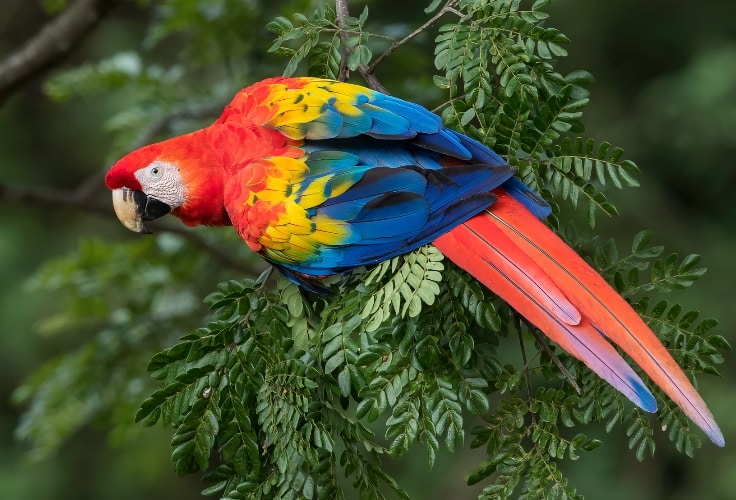
The scarlet macaw is one of the most strikingly colored parrots in the world, with a bold palette that has made it an icon of tropical biodiversity. Its body is vivid scarlet, offset by large yellow wing patches edged with green, while the flight feathers and rump are deep cobalt to pale blue.
The long tail grades from red to blue at the tip, and the bare white facial skin enhances the contrast of its brightly colored plumage. Males and females are visually identical.
This species shows no significant seasonal molt-related changes and remains colorful year-round. During courtship or social bonding, pairs may preen one another or call loudly in synchrony, often flying together in graceful, sweeping arcs over the canopy. Their deep, rolling squawks can carry across large distances in the forest, serving as contact calls and territorial signals.
Scarlet macaws inhabit humid lowland rainforests, gallery woodlands, and riverine clearings, with occasional use of drier or disturbed habitats. They range from southern Mexico and Central America to northern and central South America, including Colombia, Venezuela, the Amazon Basin, and parts of the Guianas.
Although still common in remote areas, they have been severely depleted in parts of Central America due to habitat loss and trapping for the pet trade. Local extinctions have occurred in El Salvador and large portions of Guatemala and Honduras.
Ongoing conservation efforts include legal protection, ecotourism initiatives, and successful nest-box programs in Peru. Reintroduction and education campaigns are helping reestablish populations in parts of Costa Rica and Belize, but continued threats mean active protection remains essential across much of their range.
Black-Backed Dwarf Kingfisher
Ceyx erithaca
- Color palette: Ultramarine blue, orange-yellow, lilac-rufous, and coral-red.
- Plumage notes: Slight seasonal dulling; males show more iridescence than females.
- Where found: Forested areas of the Indian Subcontinent and Southeast Asia.
- Conservation status: Least Concern.
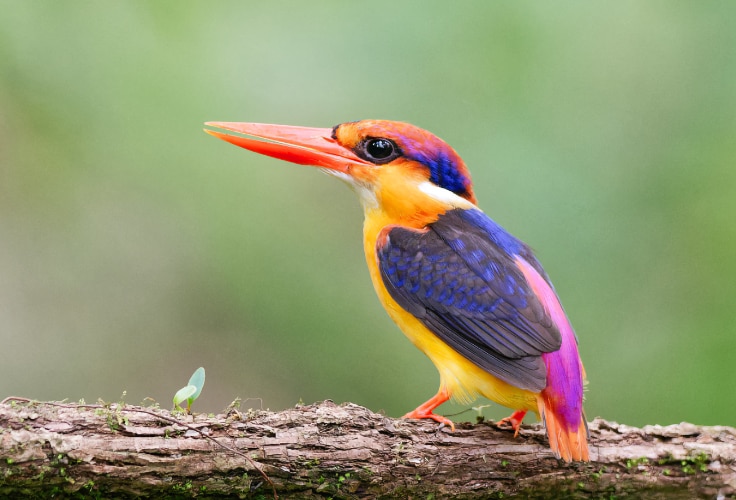
The black-backed dwarf-kingfisher is one of Asia’s most vividly adorned forest birds, remarkable for its intense contrasts and compact, jewel-like appearance. Its crown is a rich lilac-rufous with a blue forehead patch, while the back and wings gleam ultramarine-blue. The rump flashes violet in flight, and its bill, legs, and feet are strikingly coral-red. The underparts are a gradient of chrome-yellow and orange, with a crisp white throat and paired neck patches.
This kingfisher molts annually, with feather brightness slightly reduced during the process. Males retain more vivid iridescence across the crown and back, especially outside of the breeding season. During courtship, they emphasize their colors by darting rapidly through shaded forest gaps, often calling with high, whistling notes. The bird’s fast, low flight and vivid rump make it briefly conspicuous even in dense cover.
It inhabits humid evergreen forests across the Indian Subcontinent and much of Southeast Asia, often near shaded streams or dry ravines, though it is also found away from water. In South Asia, its range stretches from western India and Sri Lanka through northeastern India and into Indochina and southern China.
While still considered common in well-preserved forest tracts, this species is vulnerable to habitat degradation and fragmentation. Conservation success depends on protecting intact forest canopies and maintaining streamside vegetation across its range.
Golden-Breasted Starling
Lamprotornis regius
- Color palette: Iridescent green, turquoise, blue, purple, and golden-yellow.
- Plumage notes: No seasonal change; sexes similar.
- Where found: Dry woodlands and thorn savannas of East Africa.
- Conservation status: Least Concern.

The golden-breasted starling is one of the world’s most dazzling starlings. Its upperparts shimmer with a kaleidoscope of glossy green, blue, and purple tones, accented by a turquoise rump and long, bronzed tail.
A rich purple crescent spans the upper breast, blending into a vivid blue throat and crowned by a metallic greenish-blue head. Below, the entire underbody glows golden-yellow. A pale white iris and dark facial mask lend the bird a piercing gaze. Males and females are nearly identical in appearance, though males may have slightly longer tails.
This species does not undergo dramatic seasonal molts, and its brilliant plumage remains consistent year-round. During breeding displays, males often perch upright to showcase their chest and tail feathers, occasionally engaging in group vocalizations or soft chasing flights that draw attention to their iridescent flanks. The long, narrow tail plays a visual role in both courtship and territorial behavior.
The golden-breasted starling is found across dry bushlands, thorn scrub, and savanna habitats in parts of Ethiopia, Somalia, eastern Kenya, and northeastern Tanzania. It occurs at low elevations, typically below 1,000 meters (3,300 feet). Despite its vibrant plumage, it is often shy and keeps to small flocks, though it may become approachable near human settlements or picnic areas.
Its range is extensive and populations are stable, with large portions of its habitat falling within protected areas. As such, the species faces no major threats and remains common throughout much of its range.
Spangled Cotinga
Cotinga cayana
- Color palette: Turquoise-blue, black, and purple.
- Plumage notes: Males retain coloration year-round; females are plain gray-brown.
- Where found: Lowland rainforests of the Amazon Basin, from Colombia to northern Bolivia.
- Conservation status: Least Concern.
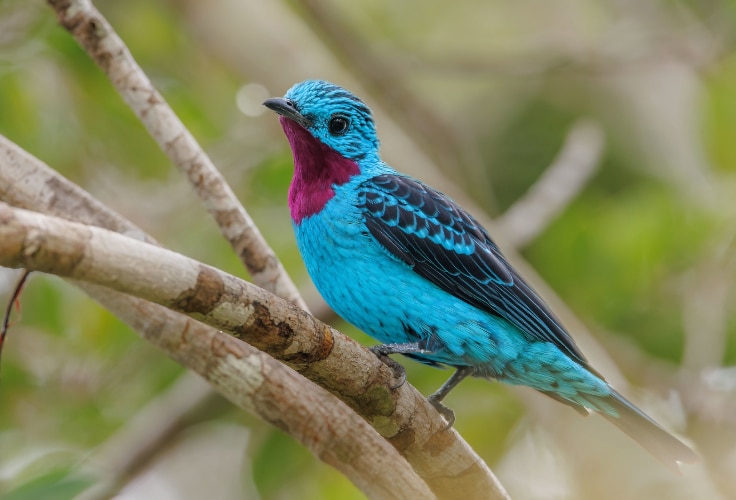
The spangled cotinga is the most vividly colored member of its genus, with males appearing almost iridescent against the green backdrop of the canopy. Their bright turquoise plumage is set off by black wings, tail, and spotted feather bases that create the namesake “spangled” effect.
A deep purple throat adds further contrast, while the female is a soft, scalloped gray-brown. Even at a distance, perched males stand out in good light, though their coloration can appear muted in shadow.
This species shows no seasonal changes in plumage. Males gather loosely in the treetops to perform display flights and postural rituals. Typical behaviors include fluffing the crown, fanning the tail, bowing, and fluttering the wings, sometimes combined with loud wingbeats during short, arcing display flights across clearings. These rituals serve to advertise presence and attract females, who may observe or chase the males before mating.
Spangled cotingas are residents of the lowland forests across the Amazon Basin, from eastern Colombia and Venezuela to Peru, Brazil, and northern Bolivia. They favor terra firme forest but also make seasonal use of flooded habitats and gallery woodlands. Mostly found in the upper canopy below 600 meters (1,970 feet), they occasionally reach elevations up to 1,350 meters (4,430 feet).
Though currently widespread and present in many protected areas, ongoing Amazonian deforestation may gradually reduce suitable habitat. Despite this, the species remains stable overall and is not considered at immediate risk.
European Bee-Eater
Merops apiaster
- Color palette: Chestnut, yellow, black, turquoise-blue, and green.
- Plumage notes: Males slightly more colorful; no dramatic seasonal changes.
- Where found: Open landscapes across Europe, western Asia, and North Africa; winters in sub-Saharan Africa.
- Conservation status: Least Concern.
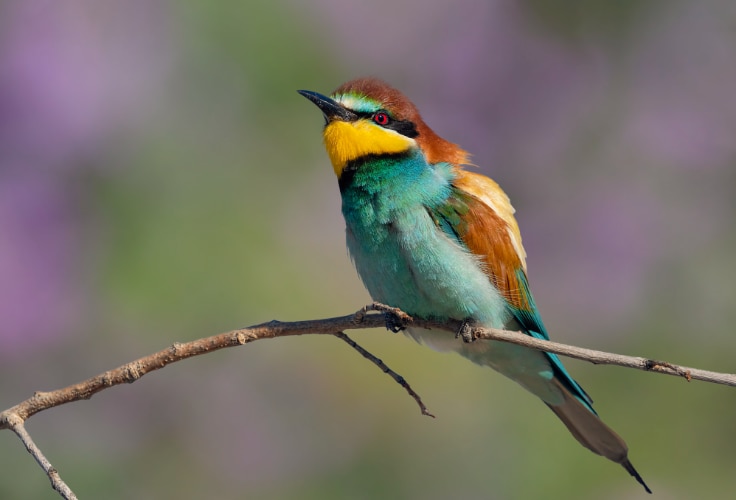
The European bee-eater is one of Europe’s most vibrantly colored birds, instantly recognizable by its chestnut crown, golden-yellow throat edged in black, and vivid turquoise underparts. The back glows with flame tones of red and orange, while the wings and tail shimmer in green and blue hues. Long central tail feathers add elegance in flight.
Males are generally brighter than females, but both sexes share the species’ dazzling palette. Bee-eaters do not undergo drastic seasonal changes, though post-breeding plumage may appear slightly duller with more green tones. Courtship involves ritualized displays: males fan their tails, fluff their plumage, vibrate their wings, and call with rolling, piping notes.
The species breeds in open or lightly wooded areas with sandy slopes or riverbanks suitable for nest burrows, often forming loose colonies. It ranges from Portugal and Morocco east to Mongolia and western China, and north to central Europe and southern Scandinavia. After breeding, it migrates to sub-Saharan Africa and parts of South Asia.
Although the population is decreasing in some areas due to agricultural changes and nesting site disturbance, the species remains widespread and common, with protected status in many countries and international conservation agreements in place.
Wilson’s Bird-of-Paradise
Diphyllodes respublica
- Color palette: Emerald-green, crimson, yellow nape cape, turquoise-blue, cobalt-blue, and iridescent violet.
- Plumage notes: Males retain full ornamentation year-round; female is duller and barred.
- Where found: Foothill and hill forests on Waigeo and Batanta islands, West Papua.
- Conservation status: Near Threatened.
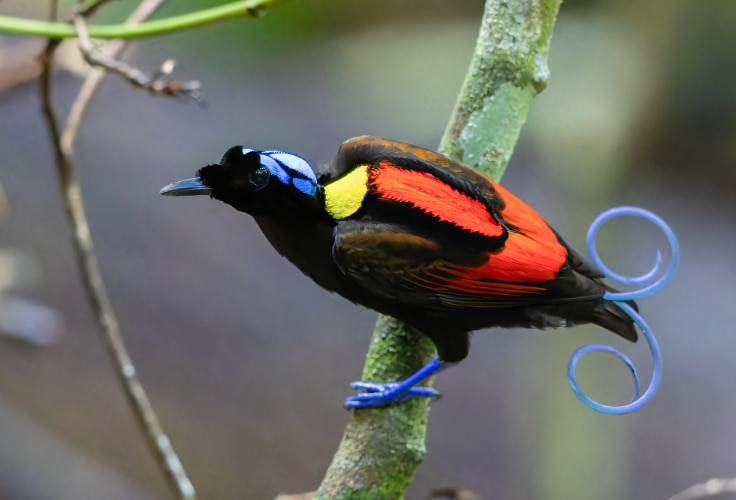
Wilson’s bird-of-paradise is extraordinary even among its famously flamboyant family, displaying one of the most complex and saturated color combinations in the natural world.
The male’s emerald breast shield glows with a smooth, oily sheen, contrasting with a bright crimson back and a semicircular yellow cape on the nape. Its unfeathered crown is a luminous turquoise-blue crisscrossed by fine black lines, while cobalt-blue legs and a pair of iridescent violet tail curls complete the palette.
Unlike many birds-of-paradise, the male maintains its full breeding plumage throughout the year. During courtship, he clears a patch of forest floor and performs ritualized displays, hopping and pivoting with wings and cape raised to highlight his vibrant colors from multiple angles. The turquoise scalp and glowing tail wires are particularly emphasized in these slow, deliberate performances.
Endemic to the West Papuan islands of Waigeo and Batanta, this species lives in lowland and foothill forests, typically from 300 to 1,200 meters (985-4,000 feet). Though it persists in selectively logged areas and seems somewhat tolerant of disturbance, ongoing deforestation, logging concessions, and historical fire damage continue to erode habitat. It is also occasionally hunted for its brilliant plumage.
While protected under CITES and found within the Pulau Waigeo Nature Reserve, enforcement and reserve boundaries remain uncertain. A promising ecotourism and conservation initiative has been launched in Waigeo’s Orobiai River catchment, aiming to reduce forest exploitation while promoting local stewardship.
Lilac-Breasted Roller
Coracias caudatus
- Color palette: Lilac, orange-pink, spring-green, blue, olive-blue, and black.
- Plumage notes: Sexes alike; no major seasonal changes in coloration.
- Where found: Open woodlands and savannas across eastern and southern Africa.
- Conservation status: Least Concern.
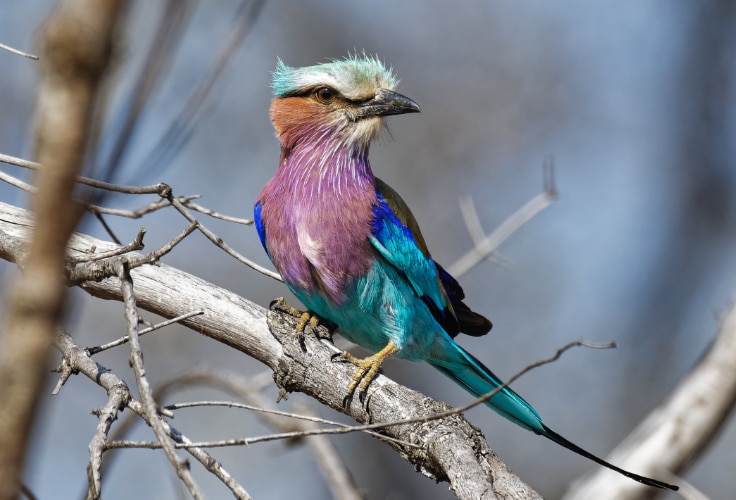
The lilac-breasted roller is one of Africa’s most visually iconic birds, renowned for its dazzling mix of pastel and jewel tones. Its lilac breast and throat transition into a bright blue belly, framed by rusty cheeks and a spring-green crown.
The wings combine deep indigo and sky-blue patches, flashing brilliantly in flight. The tail ends in two elongated black streamers that trail behind as it performs aerial maneuvers. Males and females are virtually identical in appearance.
This species does not undergo significant seasonal molt affecting plumage brightness, and both sexes retain their striking coloration year-round. During the breeding season, males perform dramatic display flights – looping, diving, and rolling from side to side while calling gutturally. These aerobatics showcase the roller’s vivid underside and wide wingspan, a behavior that gave the family its name.
The lilac-breasted roller is widely distributed across sub-Saharan Africa, found from Ethiopia and Somalia through Kenya, Uganda, and Tanzania, down to Namibia and northeastern South Africa. It favors open habitats such as acacia woodland, savanna, and lightly treed grassland, where it perches conspicuously on fence posts, bare branches, or telegraph wires. It avoids dense forest and human settlements.
The species is widespread and stable, occurring in many national parks and protected areas, with no major threats currently impacting its population.
White-Breasted Fruit Dove
Ptilinopus rivoli
- Color palette: Green, white, maroon, yellow, red, purple, and blue.
- Plumage notes: Sexually dimorphic; no seasonal changes in plumage.
- Where found: Forested lowlands and highlands across New Guinea and surrounding islands.
- Conservation status: Least Concern.
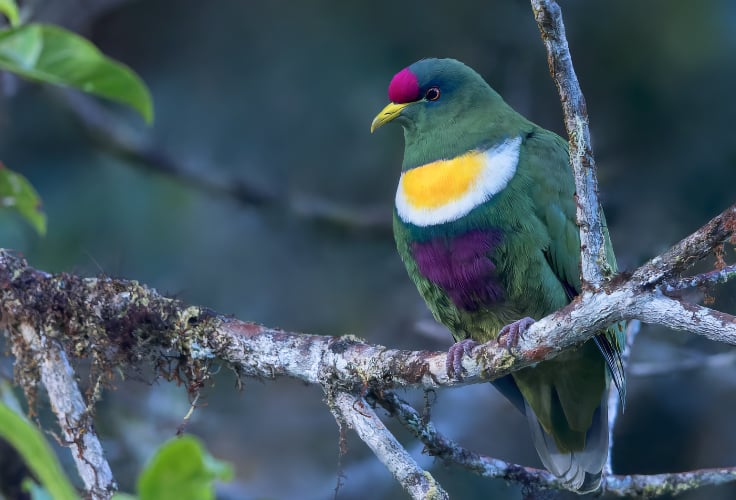
Among the world’s doves, the white-breasted fruit-dove may boast the most diverse and vivid palette – especially in the highland P. r. bellus race. Males combine deep green upperparts with a snow-white or yellow-tinged breast patch, a maroon belly spot, and a striking purplish-red forehead. Bright yellow vent feathers and small blue spots on the scapulars add even more color to the mix.
In P. r. bellus, the chest patch glows yellow at the center, edged with white, forming a layered crescent. Females lack the decorative markings but are equally bright overall, with a uniform green body, a yellowish vent, and a fine yellow line between the bill and eye.
There are no known seasonal changes in plumage. Males retain their brilliant markings year-round, and no display molt has been described. These doves are typically quiet and inconspicuous, but their bold coloration can flash through the foliage when they move or take short, whirring flights between fruiting trees.
The species inhabits tropical forests across a wide swath of New Guinea and nearby islands, including the Moluccas, Bismarck Archipelago, and Aru Islands. It can be found at sea level on smaller islands and at elevations above 3,000 meters (10,000 feet) in the New Guinea highlands.
Though its range is fragmented by island geography, the dove remains locally common in suitable habitat and has been recorded regularly in both primary and mature secondary forests. While not currently threatened, its dependence on intact forest means that continued habitat loss could affect local populations in parts of its range.
Knobbed Hornbill
Rhyticeros cassidix
- Color palette: Black, rufous, red, yellow, turquoise blue, and white.
- Plumage notes: Consistent year-round with no seasonal molt; sexes differ in coloration.
- Where found: Forest canopy of Sulawesi and nearby Indonesian islands.
- Conservation status: Vulnerable.
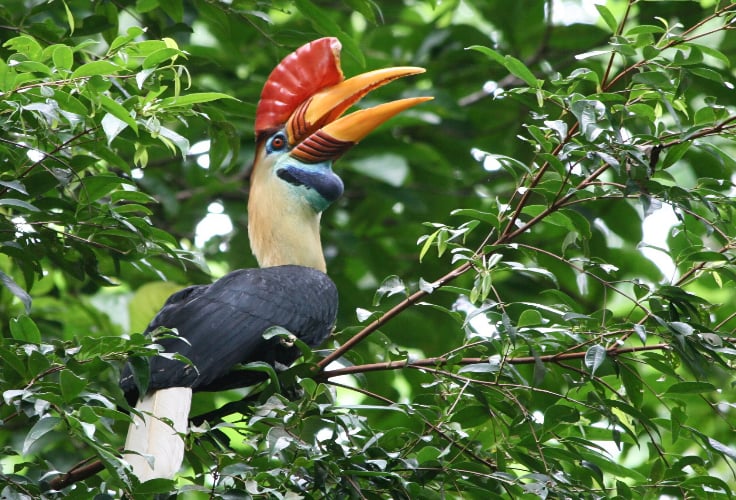
Hornbills are known for their large bills and helmet-like casques, but the knobbed hornbill stands out by adding bright colors to this already striking look. Males sport a deep rufous crown and neck, glossy black body, and an enormous yellow bill capped by a wrinkled red casque. Bare turquoise and black skin stretches across the throat, while pale blue surrounds the eye. A white tail completes the bold look.
Females are equally distinctive but differ dramatically: their neck and head are jet black, and the casque is smaller and yellow. Both sexes have vivid red “gill” patches flaring at the base of the bill.
Plumage remains consistent year-round, with no seasonal molt. During courtship, males offer fruit and perform ritualized head tossing and bill-clacking. The bill and casque are prominent in these displays, which may also serve to reinforce pair bonds. Nesting behavior is remarkable – females are sealed inside tree cavities for the duration of incubation and chick-rearing, relying on the male to deliver all food.
Endemic to Sulawesi and its satellite islands, the knobbed hornbill inhabits evergreen forests from sea level up to 1,800 meters (5,900 feet), though it prefers lowland areas below 1,100 meters (3,600 feet). It can tolerate degraded forests and ventures into plantations when foraging.
Despite being locally common, it is highly dependent on large, fruiting trees, especially figs, and on mature forest for nesting. Massive deforestation, habitat fragmentation, fires, and hunting have caused serious declines across its range. Though present in several protected areas, its patchy distribution and reliance on large trees make it particularly vulnerable.
King Vulture
Sarcoramphus papa
- Color palette: White, black, and vividly colored head in orange, red, yellow, blue, and violet.
- Plumage notes: Retained year-round with no major seasonal change.
- Where found: Lowland forests from southern Mexico to northern Argentina.
- Conservation status: Least Concern.

Among the world’s vultures, none are more visually striking than the king vulture. Its body is cloaked in white with black flight feathers, but it’s the bare head and neck that steal attention: a wrinkled, fleshy collage of orange, red, yellow, mauve, and blue, topped with a swollen wattle above the bill.
The piercing white eyes and pink throat pouch add to its dramatic appearance. While some see it as unusual or unsettling, others regard it as hauntingly beautiful – an explosion of color where it’s least expected.
Males and females look alike, though males are slightly larger and sport a more prominent bill ornament. During courtship, they engage in synchronized flights and elaborate ground or perch rituals where the vibrantly colored head is flaunted through bowing and wing displays.
King vultures are found across a vast range of tropical lowland forests in Central and South America, especially in remote or undisturbed areas. Though occasionally seen in more open woodlands or savannas, they depend on large tracts of forest for nesting and roosting.
While still widespread, their numbers are thought to be declining due to habitat destruction, primarily from agriculture and ranching. They are also occasionally targeted by trophy hunters. The species benefits from scattered protections across its range, but long-term conservation will require habitat preservation and continued monitoring of local pressures.
The Science of Avian Coloration
Bird coloration is shaped by a complex blend of evolutionary forces and biological mechanisms. Darwin’s theory of sexual selection remains one of the most influential explanations, suggesting that many brightly colored males evolved as a result of female choice.
Other theories propose that bold plumage can intimidate rivals or act as social signals in complex hierarchies. In some cases, bright colors may confuse or distract predators, but more often, cryptic coloration offers better defense.
The striking nuptial plumages seen in many male birds during the breeding season are the result of these pressures. Some species later molt into duller eclipse plumage, reducing visibility to predators once courtship ends. This shift highlights the biological cost of being colorful: vivid feathers are energetically expensive to grow and maintain, and they increase exposure to threats.
Why, then, are some birds far more colorful than others? Geography plays a role. Tropical birds often benefit from stable climates, diverse diets rich in pigments, and environments filled with saturated natural colors – conditions that favor vibrant plumage.
In contrast, many temperate species must cope with seasonal food shortages and the need for camouflage in subdued landscapes. Intricate patterning and earth-toned feathers can be just as adaptive in such habitats.
Nature’s Color Toolkit
Three main mechanisms produce color in bird feathers: pigments, structural features, and, in rare cases, a combination of both.
Carotenoids are diet-derived pigments that produce yellow, orange, and red hues. Birds cannot synthesize these themselves, so access to carotenoid-rich foods, like fruits, flowers, and insects, is essential. This makes vibrant coloration a reliable indicator of health and fitness, as only well-nourished individuals can maintain it.
Melanins are produced within the bird’s body and create blacks, grays, and browns. Besides adding color, melanin strengthens feathers and offers protection from wear and UV light. Darker feathers, particularly in flighted birds, tend to be more durable.
Structural coloration is responsible for blues, greens, violets, and iridescence. It doesn’t come from pigment but from microscopic feather structures that scatter light. This mechanism can create shimmering, multi-toned effects, including ultraviolet hues that birds can see but humans cannot.
Most of the dazzling variation seen in birds’ plumage comes from these three systems working alone or in combination. Occasionally, genetic mutations result in rare conditions like albinism, leucism, or melanism, adding further diversity to nature’s palette.
Conclusion
Bird coloration is more than aesthetic wonder – it reflects evolutionary history, ecological strategy, and physiological limits. Whether designed to dazzle a mate, blend into foliage, or withstand the elements, feathers tell a vivid story. Understanding the science behind their colors not only deepens our appreciation of birds, but also reveals how life adapts and thrives through both beauty and function.

